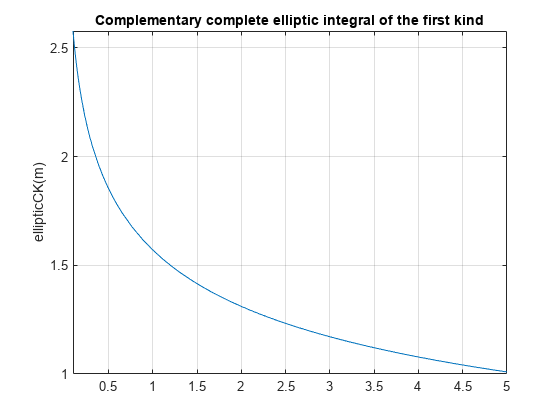ellipticCK
Complementary complete elliptic integral of the first kind
Syntax
Description
ellipticCK( returns the complementary complete elliptic integral
of the first kind.m)
Examples
Find Complementary Complete Elliptic Integral of First Kind
Compute the complementary complete elliptic integrals of the first kind for these numbers. Because these numbers are not symbolic objects, you get floating-point results.
s = [ellipticCK(1/2), ellipticCK(pi/4), ellipticCK(1), ellipticCK(inf)]
s =
1.8541 1.6671 1.5708 NaNCompute the complete elliptic integrals of the first kind for the same numbers converted
to symbolic objects. For most symbolic (exact) numbers, ellipticCK
returns unresolved symbolic calls.
s = [ellipticCK(sym(1/2)), ellipticCK(sym(pi/4)),... ellipticCK(sym(1)), ellipticCK(sym(inf))]
s = [ ellipticCK(1/2), ellipticCK(pi/4), pi/2, ellipticCK(Inf)]
Use vpa to approximate this result with
floating-point numbers:
vpa(s, 10)
ans = [ 1.854074677, 1.667061338, 1.570796327, NaN]
Differentiate Complementary Complete Elliptic Integral of First Kind
Differentiate these expressions involving the complementary complete elliptic integral of the first kind:
syms m diff(ellipticCK(m)) diff(ellipticCK(m^2), m, 2)
ans = ellipticCE(m)/(2*m*(m - 1)) - ellipticCK(m)/(2*m - 2) ans = (2*(ellipticCE(m^2)/(2*m^2 - 2) -... ellipticCK(m^2)/(2*m^2 - 2)))/(m^2 - 1) -... (2*ellipticCE(m^2))/(m^2 - 1)^2 -... (2*ellipticCK(m^2))/(2*m^2 - 2) +... (8*m^2*ellipticCK(m^2))/(2*m^2 - 2)^2 +... (2*m*((2*m*ellipticCK(m^2))/(2*m^2 - 2) -... ellipticCE(m^2)/(m*(m^2 - 1))))/(2*m^2 - 2) -... ellipticCE(m^2)/(m^2*(m^2 - 1))
Here, ellipticCE represents the complementary complete elliptic
integral of the second kind.
Find Elliptic Integral for Matrix Input
Call ellipticCK for this symbolic matrix. When the input argument is
a matrix, ellipticCK computes the complementary complete elliptic
integral of the first kind for each element.
ellipticCK(sym([pi/6 pi/4; pi/3 pi/2]))
ans = [ ellipticCK(pi/6), ellipticCK(pi/4)] [ ellipticCK(pi/3), ellipticCK(pi/2)]
Plot Complementary Complete Elliptic Integral of First Kind
Plot complementary complete elliptic integral of first kind.
syms m fplot(ellipticCK(m),[0.1 5]) title('Complementary complete elliptic integral of the first kind') ylabel('ellipticCK(m)') grid on hold off

Input Arguments
More About
Tips
ellipticKreturns floating-point results for numeric arguments that are not symbolic objects.For most symbolic (exact) numbers,
ellipticCKreturns unresolved symbolic calls. You can approximate such results with floating-point numbers using thevpafunction.If
mis a vector or a matrix, thenellipticCK(m)returns the complementary complete elliptic integral of the first kind, evaluated for each element ofm.
References
[1] Milne-Thomson, L. M. “Elliptic Integrals.” Handbook of Mathematical Functions with Formulas, Graphs, and Mathematical Tables. (M. Abramowitz and I. A. Stegun, eds.). New York: Dover, 1972.
Version History
Introduced in R2013a
See Also
ellipke | ellipticCE | ellipticCPi | ellipticE | ellipticK | ellipticF | ellipticPi | vpa